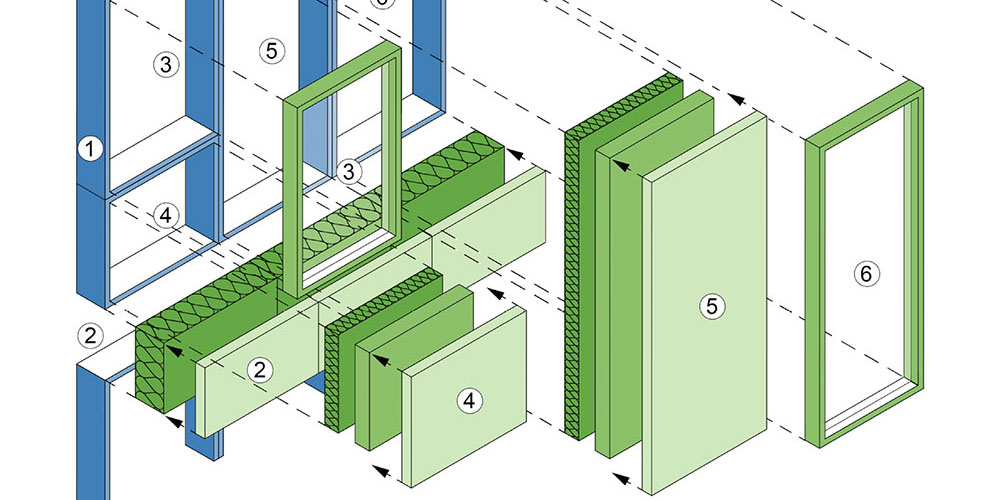Downloads
DOI:
https://doi.org/10.7480/jfde.2019.1.2772Keywords:
Refurbishment, Modular, Circular Economy, Renewable Energy Sources (RES), Building Integrated Photovoltaics (BIPV)Abstract
The construction of office buildings in particular, as well as multi-family dwellings, are largely based on regular planning grids, and the widths of such grids appear to be repetitive across Europe.
In the EU project, PLUG-N-HARVEST, a multi-modular façade system for refurbishment, based on these planning grids, is developed. To achieve a comprehensive improvement of the building´s energy efficiency, different solutions for active and passive energy demand reduction, as well as harvesting of heat and power were combined, while also taking into account the existing building structure, climatic region, and usage profile.
The PLUG-N-HARVEST façade is designed to enclose the existing façade like a second skin. Thus, the remaining protection provided by the existing outer shell allows continuous usage. The modular approach enables economic efforts by serial production with a high degree of prefabrication and thus shortened assembly time. At the same time, the toolkit design follows the principles of the circular economy. In visual terms, various façade surfaces will be available to allow both an orientation to the existing building and an aesthetic reorientation.
In 2019, pilot buildings in Greece, Spain, the United Kingdom, and Germany aim to show the adaptability of the modular toolkit to different façade geometries and to assess its ecological and economic benefits.
How to Cite
Published
Issue
Section
License
Copyright (c) 2019 Verena Dannapfel

This work is licensed under a Creative Commons Attribution 4.0 International License.
Authors or their institutions retain copyright to their publications without restrictions.
References
Buildings Performance Institute Europe. (2011). Europe´s buildings under the microscope: A country-by-country review of the energy performance of buildings. Brussels.
Bundesministerium für Umwelt, Naturschutz und Reaktorsicherheit, & Bundesministerium für Wirtschaft und Energie. (2015). Bekanntmachung der Regeln zur Datenaufnahme und Datenverwendung im Wohngebäudebestand [Publication of rules on data collection and use in the residential building stock].Berlin.
Deutsche Energie-Agentur GmbH. (2018). dena-Gebäudereport kompakt 2018: Statistiken und Analysen zur Energieeffizienz im Gebäudebestand [dena building report compact 2018: Statistics and analyses on energy efficiency in existing buildings]. Berlin.
Deutsche Energie-Agentur GmbH. (2017). Büroimmobilien: Energetischer Zustand und Anreize zur Steigerung der Energieeffizienz [Office properties: Energy status and incentives to increase energy efficiency]. Berlin.
Ebbert, T. (2010). Re-Face: Refurbishment strategies for the technical improvement of office façades. (Doctoral dissertation). Delft: Technische Universiteit Delft.
Europäisches Parlament. (2018). Gesamtenergieeffizienz von Gebäuden [Energy performance of buildings]. Brussels.
European Commission, & Joint Research Center. (2015). Energy Renovation: The Trump Card for the New Start for Europe. Brussels.
European Commission. (2016). Accelerating clean energy in buildings: Clean Energy For All Europeans. Brussels.
Deutsche Energie-Agentur GmbH. (2016). dena-Studie: Auswertung von Verbrauchskennwerten energieeffizienter Wohngebäude. Berlin.
MCDonough Brangart Design Chemistry. (2016). C2CCertified Product Standard V3.1. Charlottesville,Virginia.
Green, M. A., Hishikawa, Y., Dunlop, E. D., Levi, D. H., Hohl-Ebinger, J., & Ho-Baillie, A. W.Y. (2018). Solar cell efficiency tables (version 51). Progress in Photovoltaics: Research and Applications, 26, 3-12. Retrieved from https://doi.org/10.1002/pip.2978
Wietschel, M., Ullrich, S., Markewitz, P., Schulte, F., & Genoese, F. (2015). Energietechnologien der Zukunft [Energy technologies of the future]. Wiesbaden: Springer Fachmedien Wiesbaden.
